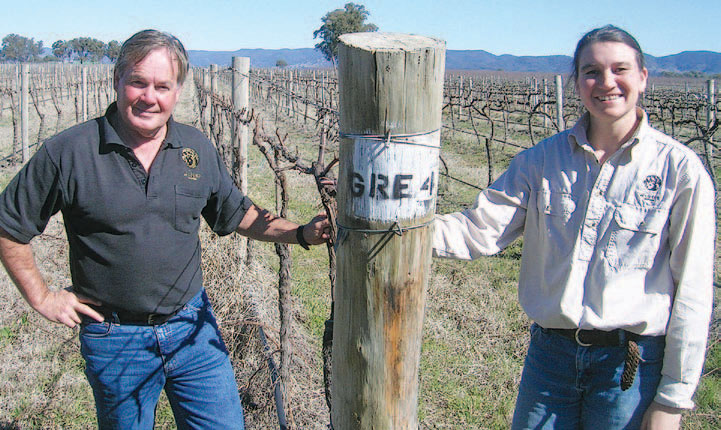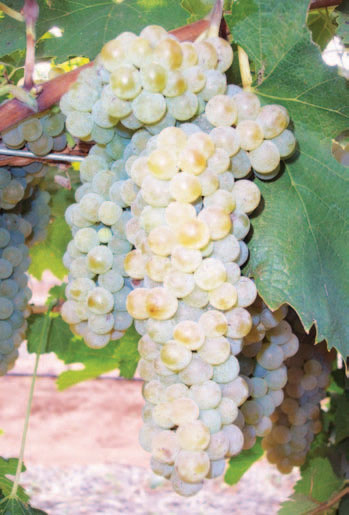By Rob Fairall and Julia Conchie, di Lusso Estate, Mudgee, New South Wales. Email: [email protected]
First published in the September/October 2011 issue of the Wine & Viticulture Journal

HISTORY
Like so many ancient Italian varieties, Greco has its origins in Greece, as does Aleatico and Vermentino which are also grown on our small estate in Mudgee.
More than 3000 years ago, when Magna Grecia was at its peak, colonising Greeks brought Greco to several of its southern Italian colonies, including the one around Avellino, in Campagna. The small town of Tufo (population 1000) is just 20km north, its vineyards scattered around the alluvial valleys and sharp volcanic hillsides of that region.
After the Second World War, the vineyards of this region – along with most in the southern mainland – were drastically reduced in size and commercial importance as the population emigrated to find work and lifestyle. It was only after government intervention in the 1960s that the industry began to stabilise (helped by the establishment of the country-wide appellation infrastructure).
THE VARIETY
Greco is a late-maturing variety, with the grapes formed in small, tight bunches with winged clusters. The variety is regarded as a relatively light cropper.
After veraison the grapes turn a golden-grey color. The phenolic compounds in the grape contribute to the wine’s characteristically deep colour.
In terms of other varieties, Greco is similar in profile to Verdiccio, some Malvasia clones, and it is said by some to be the ‘Italian Viognier’.

WHY WE CHOSE GRECO
In short, because it has an interesting story, has good pedigree and possesses some important points of difference from other wines on our list (despite some differences between the mixed volcanic clay soils around Avellino and our own clay-loam).
Greco di Tufo is one of only two DOCG white wine styles in the southern half of Italy (the other being Fiano). Greco Bianco (one of its many other aliases) also produces a very good passito-style dessert wine further south in Calabria (and is potentially a fallback source for our own passito).
As already mentioned, Greco produces a wine relatively deep in colour – a clear, bright light gold, thus, contrasting sharply with our other two dry white wines, Pinot Grigio (particularly) and Vermentino.
Like many Italian varietal wines, Greco is noted for its aromatics – in general terms, green melon, almonds and minerals; again, a contrast to the tropicality of Pinot Grigio and citrus of Vermentino.
Greco’s flavour and texture profile – ‘mouth-wateringly’ acidic, yet, richer than the others, with greater complexity and length – enables us to promote the style as a very good companion for heavier, more textured fish; even spiced white meat dishes such as Mongolian chicken.
This is another point of difference, as is the variety’s purported characteristic of gaining even further complexity and interest with age.
And, finally, Greco is well-known to have been the wine of choice of Luciano Pavarotti; allegedly, the great singer downed a glass or two to get his palate in shape before a recital. If it’s good enough for the great man, it should be good enough for mere mortals like us!
GRECO IN THE VINEYARD
The di Lusso Estate vineyard was planted in 1999, but the Greco is one of the most recent additions. It was introduced into the di Lusso mix in spring 2008 when it was grafted onto two rows of Barbera (400 vines/half an acre).
Bud wood was sourced from Chalmers Nursery, in Euston, New South Wales, and two chip buds per vine were grafted.
The Barbera is on Kober 5BB rootstock, so we may have the first Greco/Barbera/ Kober 5BB combination in Australia.
It was definitely not a combination for which we could find incompatibility risk information. General virus testing was, therefore, carried out on the Barbera, with the results indicating ‘virus-free’, so the grafting went ahead.
Having been grafted only three years ago (giving us two years of fruit production), Greco is still very much a work in progress for us as we learn more about how it grows on our site and behaves in our climate. Year one (2008-09) involved training the grafts up on to the wires. Year two (2009-10) was our first crop, but it was very wet and we learned that the small, tightly packed bunches were very susceptible to botrytis and other bunch rots and, very rapidly, the fruit disintegrated.
In year three (2010-11), having learnt from the previous year’s demise, we made some changes. Every attempt was made to create as much airflow as possible through an open canopy. Shoot and bunch thinning were carried out to remove extra shoots and bunches that created crowding.
Our aim was for each bunch to hang separately. This also enabled good spray penetration. This work, plus a thorough spray regime, proved successful and we hand-picked 1.4 tonne of disease-free fruit in a very tough season climatically.
With regard to other diseases, we observed throughout last season that Greco seems quite resistant to downy mildew; we haven’t observed any powdery mildew at all (but powdery mildew has never been a problem in our vineyard).
Greco has a long growing season and ripens late in the season. This year’s crop was picked on 28 March at 12.7 Baume, pH 3.19 and TA 8.0. The usual challenge of striving for flavour and the balance between sugar and acid exists, but, with Greco, it is more about waiting for the acid to retreat.
The block is spur pruned and will continue to be hand harvested for fruit integrity and due to the young age of the graft unions.
GRECO IN THE WINERY
The 2011 vintage is the first Greco we have made and it was bottled at the end of August. As in the vineyard, it was quite different and challenging in the winery.
The first difference was that the ferment was very slow and steady (much slower than our Pinot Grigio and Vermentino ferments). The second hurdle was protein stabilisation. Many bentonite trials were conducted with varying and very strange results. The stabilisation appeared to be getting worse as the bentonite rates increased. We adopted a strategy of adding a modest amount of bentonite semi-based on the trial results and tested for stability, but the results were still inconclusive. After consultation and investigative tests through the AWRI, we discovered the wine was protein stable but had a high polysaccharide content which was interfering with the bentonite testing.
A glucanase enzyme was then added to facilitate filtration (which was successful), as we couldn’t afford to lose any of the small volume. The third hurdle was the small batch and volume, as losses at every step were higher and procedures, such as cold stabilisation, are more difficult. The fourth hurdle was the acid. Shortly after ferment, the acid was very aggressive, which was concerning, but after three months it mellowed remarkably to still carry the acid prominence for which the variety is known, without the harshness.
The challenges and experiences with new varieties keep us thinking and learning as winemakers. We are very pleased with our first vintage of this intriguing variety and are excited about the journey to come with Greco in our portfolio.
GRECO

By Peter Dry, Emeritus Fellow, The Australian Wine Research Institute
Background
There are many synonyms of Greco (pronounced grey-KOH)—these include Balsamina Bianca, Biancame, Greco Biondello, Greco Castellano, Greco del Vesuvio, Greco delle Torre, Greco di Gerace, Greco di Napoli, Greco Maceratino, Greco Moneccio, Grecula , Grieco, Montecchiese and Morbidella. Greco comes from southern Italy, particularly Campania. It is best known for the wines of the DOCG Greco di Tufo from the hills around Avellino, east of Naples, where the vineyards are at 400-700 m. The name Greco is very widespread in Italy, as it has been a generic name used to indicate a variety of potential Greek origin. There are also Greco Bianco and Greco di Bianco grown in neighbouring Calabria—but these are different varieties, with Greco di Bianco corresponding to Malvasia di Sardegna of Sardinia and Malvasia di Sitges of Spain. As well as the DOCG Greco di Tufo, the variety is used in blends in other provinces of Campania. Globally there were 158 ha in 2010, close to 100% in Italy. In Australia there are currently at least 5 wine producers, mainly in SA, NSW and Vic.
Viticulture
In Australia, Greco bursts early but ripens late. It has an erect growth habit, bunches are small, often winged and compact. Yield is low to medium. The small berries have thin and tender skin. Its susceptibility to Botrytis may limit its use in areas of high humidity/rainfall. In Italy, it is said to perform best at 400-700 m—it is likely that this is not because it prefers high elevations but rather that the high elevation sites have the most suitable climate for the desired wine specifications. The fact that it tends to be blended with other varieties when grown at low elevation may support this assumption. The main rootstocks used in Campania are 1103P, SO4 and 5BB. Richter 110 has been used at Langhorne Creek. Cane pruning is used in Campania but it can be spur-pruned in Australia. Greco is susceptible to Botrytis bunch rot with varying reports of tolerance to downy and powdery mildews.
Wine
Greco wines can be impressive with good flavor, structure, minerality and texture. Flavour descriptors include savoury, jasmine, pear, honey and citrus. The relatively few wines made in Australia have shown that it maintains high acidity in hot climates—for example, 12.8 Be, 3.24 pH, 8.9 g/L titratable acidity at harvest in mid March in the Murray Darling region (K. Chalmers, pers. comm.). It is prone to oxidation. The natural fine fruity bouquet and good structure may be enhanced by brief skin contact. Tasting notes on the 2009 Beach Road Greco from the workshop on ‘Emerging Mediterranean varieties in Australia’, 2010 Aust. Wine Ind. Tech. Conf.: “…a bit like Marsanne, lemon, talc, acid backbone/phenolic structure, long dry finish”.




















